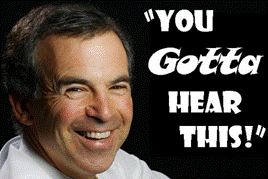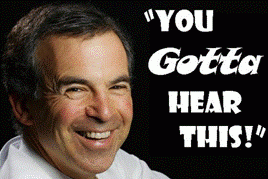For years now it’s been obvious that the classical orchestral concert is in need of some rethinking for modern audiences. And no one has been more out in front of this issue than the San Francisco Chamber Orchestra, which began its popularizing mission by giving all its concerts away for free. Its current music director, Ben Simon, has gone the full monty, trying out a variety of new ideas, including the short, entertaining programs called “Classical at the Freight,” presented once a month for the past three years at the Freight and Salvage Coffeehouse in Berkeley.

At “Classical at the Freight,” the emphasis is placed on informal interaction with the musicians, which is usually in short supply at a classical concert, as well as on demystifying the entire classical experience. Yet those shows reach only a portion of SFCO’s audience, so Simon’s new venture, “You Gotta Hear This” at the Rrazz Room in San Francisco on Sept. 12 at 2 p.m., is an expansion on his original ideas.
“I’ve always done a 10-15 minute intermission feature at the Freight, where I engage the audience, talk directly to them,” says Simon. “And I’ll do fun things like trivia quizzes — like I’ll ask, ‘Which of the following was not one of Mozart’s given names: Johann, Wolfgang, Chrysostom, Theophilus, or Popeye.’ [There was a memorable contest to provide a nickname for a Haydn symphony, a few months ago. The “Duck Symphony” lost out to the “Freight and Salvation Symphony.”] So it’s educational, but with a huge helping of sugar.
“There’s always been a great response, so I thought it would be interesting to try a whole concert modeling it after a radio show. You know, we’re trying to attract new listeners who have never attended a classical concert. So “You Gotta Hear This” will be in the afternoon, and people will come in, have a drink, and listen to an hour concert — not all classical.”
On the first program, flutist Tod Brody and double bassist Michael Taddei will share the stage with Teslim (Kaila Flexer on violin, Gari Hegedus on oud), a duo that will perform some Greek, Turkish, and Sephardic music. Simon will play the congenial host, chatting with the musicians and trying out a potpourri of ideas to engage the audience in the music.
“Basically, the underlying theme is, we’re teaching an audience how to listen,” Simon continues. “So we’ll be entertaining them, but at the same time feeding them a little bit of theory and background. We’ll play ‘Name That Classical Tune’ and other listening games, and make it fun. I’m always conscious, whenever I do a preconcert talk, of how little I’ve actually conveyed about the music, and yet people come up to me afterward and say it really helped them. Which shows you don’t have to do that much to connect people to this music.”
The SFCO has already drawn some serious interest from radio stations in its prototype radio show. “Ideally, I’d love to have ‘You Gotta Hear This’ air between Car Talk and Wait Wait … Don’t Tell Me! [on NPR Radio]. We’ll do a few concerts and see where it leads.”
Tackling Critical Survival Challenges
Behind SFCO’s initiatives is the realization, shared by a wide variety of organizations and administrators in the classical world, that the shrinking audience and decreased funding for traditional symphony and opera concerts is becoming critical. The decline in attendance has been amply documented in the National Endowment for the Arts’ 2008 report on arts attendance, which showed steep declines in attendance at classical concerts in the core 45- to 64-year-old age group between 2002 and 2008; the decline goes back to 1982 at least. Simon’s analysis of the decline is apparent in his remedies: His concerts are informal, shorter, and educational, and they mix a wide variety of repertory, from commissions to classics to nonclassical genres. Simon’s diagnosis falls into five categories.
To begin with, Simon relates, “People like to hear what they’re familiar with.” This is bad news for classical music, given that most people have grown up in an era when nonclassical genres have dominated the air waves and cultural news, while classical music has been steadily receding. “When I was growing up,” Simon recalls, “we had Leonard Bernstein’s ‘Young People’s Concerts.’ There were three classical reviewers on the [San Francisco] Chronicle staff, not to mention orchestras in the schools.” With much of that infrastructure gone, there’s a lot of slack to take up. Simon mentions the San Francisco Symphony’s “Keeping Score” programs as a bright light in music education, but there’s much more to do.
Classical music hasn’t helped itself with this audience that has been marinating in “popular” genres. “People think they have to know something to go to a classical concert — that there’s this esoteric body of insider knowledge you have to possess before you can go. Classical music has been presented as intimidating,” Simon explains. “One of my friends said to me, a little while ago, ‘This Schubert concert looks nice, but I don’t know if I should go.’ Honestly, what do you need to know to love Schubert?”
A third problem is the concert hall and its peculiar etiquette, which is increasingly out of step with American life. “I’ve found that people don’t want to sit for two or three hours. Without ‘dumbing down,’ I’ve made concerts one hour. And wouldn’t it be cool if in a concert hall you could dance to the dance music or spontaneously express your enthusiasm for an upbeat piece?” These behaviors are encouraged at SFCO concerts, and Simon has led the way in exploring alternative venues, which is why the new series is set at the Rrazz Room, a popular venue for cabaret and jazz acts.
Breathing Life Back into Classical Orchestras
“Orchestras should not be museums,” Simon continues. “We’re not a contemporary music orchestra, but SFCO has a robust commissioning project.” Still, the conductor is aware that that alone isn’t going to solve the problem. “The old idea is, you sneak your token modern piece in before intermission and then hope people will come back when you can soothe them with Brahms or Tchaikovsky. That model is failing.”
The solution to that dilemma is increasingly apparent in the work of composers who live in the wake of minimalism, a style that did much to break down boundaries between genres. The path was trailblazed by Bernstein himself, whom Simon echoes on this issue. “Someone [photojournalist W. Eugene Smith] said, ‘Hardening of the categories leads to art failure.’ I like to present good music — whatever the category,” Simon remarks.
“The word classical turns people off,” he continues. “But there are tons of jazzy, rock, and even pop influences in orchestral music now. Look at John Zorn, Frank Zappa — their classical pieces are almost rock, in some ways. Gabriela Lena Frank, Paul Dresher, and Yu-Hui Chang [among composers the SFCO has commissioned over the past few seasons] are branching out in all kinds of directions that involve other styles.” If diversity is the name of the game, SFCO is in the middle of it. The Rrazz Room date with Teslim is not going to faze musicians who have worked with circus clowns, among other partners. “We’re not afraid of having fun,” Simon concludes. “I’m not sure if this experiment will work. We’ll see.” That’s how it is when you’re leading the band.

